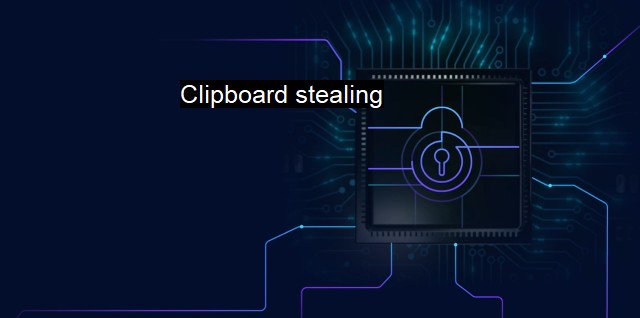What is Clipboard stealing?
Clipboard Stealing: The Hidden Danger Lurking in Your Digital Environment
Clipboard stealing is a cybersecurity threat that is emerging as a major concern in the highly digital world we live in today. This term refers to a specific type of cyberattack where the attacker takes control of a victim's clipboard, accessed readily on any digital interface, and uses the contents to their advantage without the victim's knowledge. A clipboard in this context is the temporary storage area on your device which retains a copy of texts, images or other data that you have cut or copied from documents, web-pages, and other applications, which can be pasted elsewhere.The clipboard, a convenience designed to facilitate better interaction among different apps/interfaces, becomes an issue when sensitive data passes through it. In a clipboard stealing attack, a malware monitors this clipboard and captures any data that the user has copied. Everything from innocuous pieces of information, such as email addresses or phone numbers, to highly sensitive data like usernames, passwords, credit card numbers, and other credentials could potentially be stolen in this way.
The rise of cryptocurrency has brought clipboard stealing into the limelight. Cybercriminals specifically designed some strains of malware to monitor clipboards for Bitcoin or other cryptocurrency addresses. When it spots such an address, it then replaces this string of characters with the address of a cybercriminal’s cryptocurrency e-wallet. Unsuspecting victims continue their transactions as usual without knowing the destination of their funds has been swapped.
Stealing from the clipboard isn't limited to malware installed on a victim's machine, either. Some malicious website scripts are well capable of accessing a visitor’s clipboard during the routing browsing activity, fetching its content regardless of whether it's relevant to the site.
Clipboard attacks happen subtly with invisible, highly sophisticated malware, often going unnoticed until it becomes too late. Cybersecurity and antivirus solutions have, therefore, evolved over the years to not only defend against traditional threats but also to include features that offer protection against clipboard-based attacks.
These antivirus solutions employ monitoring capabilities that keep an eye on your clipboard. They make note of normal clipboard behavior, detecting any abnormal trends, indications of suspicious alterations or connecting to the network, and mitigating the issue before personal information can be siphoned off. Apart from alerting the system owner, they have the capacity to quarantine and delete harmful entities.
Given that clipboard-based compromises have been growing, individuals and businesses are encouraged to practice good cybersecurity hygiene, including not copying private data such as passwords and bank details, and using secure platforms for transactions. high-quality anti-malware software applications remain critical for comprehensive protection.
Clipboard stealing poses a serious, stealthy security risk that often goes overlooked. Its prevalence underlines the fact that cybercriminals are continually learning, adapting, and exploiting every possible cybersecurity weakness available. That's why it's increasingly important to adopt innovative cross-platform antivirus solutions that provide robust defenses against an ever-widening array of threats. These tools are the necessary protective buffer in our world where digital interactions and transactions have become the norm -- a world in which clipboards, once secure, have become entries for stealthy cloaked invaders.
Understanding clipboard stealing helps shed light on how the convenient features of our devices can be manipulated towards nefarious ends. Gaining this knowledge and acting on it is the first and most crucial step towards securing our digital life from invisible threats lurking at every turn. Proactive measures, like smart use habits and dependable antivirus software, can effectively fortify our defenses against the surreptitious but very potent threat of clipboard stealing.

Clipboard stealing FAQs
What is clipboard stealing and how does it work?
Clipboard stealing is a type of cyber attack where malware or malicious code is used to steal information stored on a user's clipboard. When users copy text or data to their clipboard, such as passwords or sensitive information, the malware steals that information and sends it to the attacker. This attack works by exploiting vulnerabilities in the system or software to gain access to the clipboard content.How can I protect myself from clipboard stealing attacks?
To protect yourself from clipboard stealing attacks, you can use antivirus software and keep it updated regularly. Also, avoid visiting untrusted websites, downloading files from unknown sources, and clicking on suspicious links. Additionally, you can use a password manager to store your passwords and avoid copying and pasting sensitive information, whenever possible.What are the signs of a clipboard stealing attack?
The signs of a clipboard stealing attack may vary, but there are some common symptoms that indicate your clipboard has been compromised, such as unexpected password changes, unauthorized access to your accounts, and abnormal computer behavior. If you notice any of these signs, it is recommended to run a virus scan and contact your IT department immediately.Can antivirus software detect clipboard stealing malware?
Yes, most antivirus software can detect clipboard stealing malware and protect your system from such attacks. However, it is important to keep your antivirus software updated regularly to ensure that it has the latest virus definitions to defend against new threats. Also, make sure to enable real-time scanning to detect and block any suspicious activities in real-time.| | A | | | B | | | C | | | D | | | E | | | F | | | G | | | H | | | I | | | J | | | K | | | L | | | M | |
| | N | | | O | | | P | | | Q | | | R | | | S | | | T | | | U | | | V | | | W | | | X | | | Y | | | Z | |
| | 1 | | | 2 | | | 3 | | | 4 | | | 7 | | | 8 | | |||||||